Tuesday, 4 December 2012: Wellington, the zoo
Each day's session at the meeting began with a plenary speaker, scheduled for 8:15 through 9:30 a.m. In the advance copy of the program circulated before the meeting, the schedule listed only last names, so we couldn't always be sure just who the speaker was. When we arrived in Wellington, though, the copy of the schedule we received at registration made clear that the "Cameron" listed as speaking on Tuesday morning was, in fact, James Cameron, the film-maker (e.g., Titanic, Avatar). He spends so much time in Wellington (filming the Avatar movies) that he has a home there. On the side, when he's not making movies, he's interested in deep-sea exploration and recently set (yes, personally) a new record for deepest dive in a manned submersible, narrowly edging out the old record, which had stood since the days of the bathyscaphe!
His presentation was scheduled for the building's largest auditorium, which could seat everyone with some places left over, so I found a spot in the back and sat in on it. He was a very good speaker, and the topic was fascinating, but unfortunately, the film he had prepared showing the design process, construction of the submersible, and his dives in it had to be flown in overnight from Los Angeles and was late in arriving. He had just arrived at the end of his allotted time when the breathless messenger, still wearing his motorcycle helmet, dashed into the room with the crucial computer disc in his hand. By acclimation, the audience agreed to delay the first scientific talk of the day (which, coincidentally, was David's) so that he could show at least part of the film. Talk about a hard act to follow!
I then adjourned to the lobby, researched city bus schedules and the weather (Te Papa is a free wi-fi hotspot), dropped my computer back at the hotel, and went to the zoo.
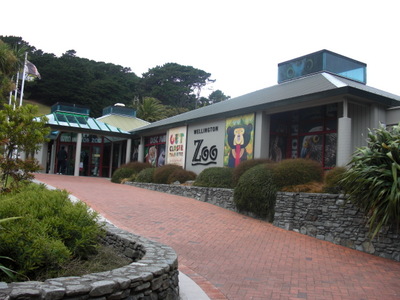
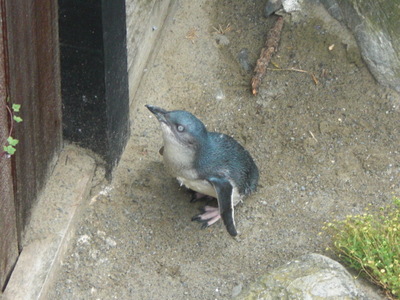 Wellington is built around the shores of its harbor, so naturally anywhere else you go is going to be uphill, and in this case, rather steeply uphill at that. The cablecar heads northwest from the center of town, whereas the number 10 bus, which goes to the zoo heads out almost due south. (By that sort of coincidence that happens to me all the time, I spent my time waiting for the bus on Courtenay Place chatting in French with a nice lady from Paris who was in town to visit her daughter, who works in the film industry.)
Wellington is built around the shores of its harbor, so naturally anywhere else you go is going to be uphill, and in this case, rather steeply uphill at that. The cablecar heads northwest from the center of town, whereas the number 10 bus, which goes to the zoo heads out almost due south. (By that sort of coincidence that happens to me all the time, I spent my time waiting for the bus on Courtenay Place chatting in French with a nice lady from Paris who was in town to visit her daughter, who works in the film industry.)
At the left is the main entrance building, inside which I had another undistinguished snack-bar lunch (pizza this time, I think) before setting off to explore.
At the right is one of the first animals I encountered, and one I had particularly wanted to see: the blue penguin (Eudyptula minor). It's the smallest of all penguins, stands only about 25 cm tall, and is incredibly cute, although I thought it looked rather forlorn. If we'd had a car, or wanted to sign up for a half-day tour, we could have gone to see them in the wild, not very far from Wellington.
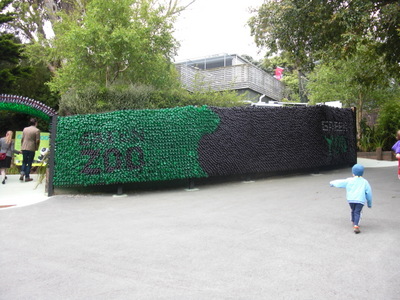
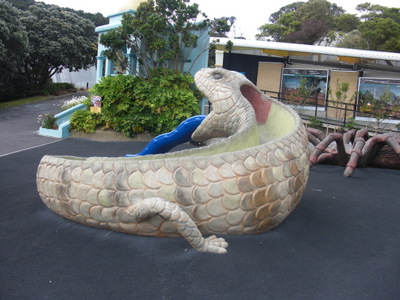 It's a small zoo, in areal extent, and many signboards were at pains to explain why they don't have, for example, elephants— they can't provide space enough to keep such large animals happy and healthy without displacing a lot of other exhibits, so they've decided to concentrate on native species and species that are especially rare in zoos.
It's a small zoo, in areal extent, and many signboards were at pains to explain why they don't have, for example, elephants— they can't provide space enough to keep such large animals happy and healthy without displacing a lot of other exhibits, so they've decided to concentrate on native species and species that are especially rare in zoos.
They are also very big on being green—a whole compound was devoted to illustrating the principle, and it was enclosed in this impressive wall of bottles (thrust into the openings of chain link, the way people use plastic cups around here to advertise to passing traffic).
At the right is what they consider playground equipment. The slide in the foreground is in the shape of a giant lizard (a skink maybe?); in the background at the right is a tarantula for climbing.
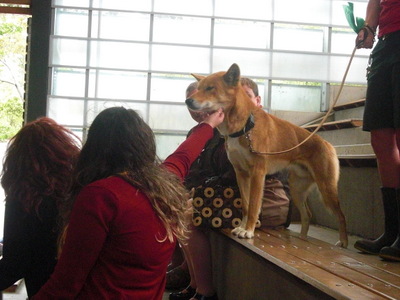
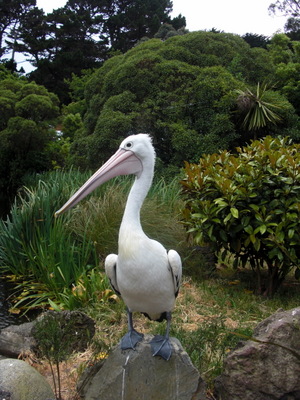 At one point, I rested my feet by showing up to watch the presentation on the "animal of the day," which turned out to be the dingo. After the short talk, the keepers brought the two leashed dingos out into the small audience to be petted. They were very wooly and soft, very friendly, and loved having their chins and ears scratched. The keepers emphasized that all zoo animals are trained, for their own health and safety as much as anything else, although not necessarily tame. For example, even dangerous animals like lions and tigers are trained, e.g., to present the left hip to a mesh-screened window on command, to facilitate administration of injections and drawing of blood samples.
At one point, I rested my feet by showing up to watch the presentation on the "animal of the day," which turned out to be the dingo. After the short talk, the keepers brought the two leashed dingos out into the small audience to be petted. They were very wooly and soft, very friendly, and loved having their chins and ears scratched. The keepers emphasized that all zoo animals are trained, for their own health and safety as much as anything else, although not necessarily tame. For example, even dangerous animals like lions and tigers are trained, e.g., to present the left hip to a mesh-screened window on command, to facilitate administration of injections and drawing of blood samples.
I also passed by the home of the Australian pelican just before the regularly scheduled "pelican talk." Clearly the pelican knew the routine (he must get a treat for showing up), because he had come from far away across the pond to perch on this rock, just inside the fence (which was only waist high, clearly intended to keep people out rather than the birds in). I was astonished at his size! That bird stands five feet tall!
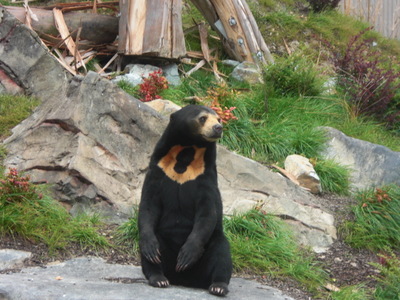
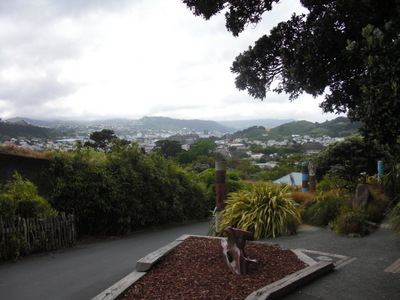 At the left is the Malaysian sun bear, a new acquisition.
At the left is the Malaysian sun bear, a new acquisition.
At the right is a view from a high spot in the zoo back over the city of Wellington. The wind was ferocious up there in the hills, especially at this particularly exposed spot.
In addition to the animals I could get decent photos of, I saw many others—lots of native parrots and other birds, the red panda, giraffes (whose enclosure was provided with a viewing deck at their head height, so that they could come right up and lick your face, as one of them offered to do in my case—I hope he wasn't offended when I backed up hurriedly), lions, tigers, cheetahs, meerkats, lots of marsupials, lots of African ungulates, ostriches and emus, otters, primates (a nice collection of the smaller marmosets and tamarins), and (in a special building in which the lighting regime was reversed) kiwis. The keeper also pointed out a morpork (a small local owl) that also shares their enclosure. The two kiwis on display are both males, their territories bounded by low walls and separated by the walkway down the center. They run around in the dim red light making soft little grunts and woonk-woonk noises, probing the ground with their beaks, until they both happen to be at the same end of their territories at once, at a spot where the path is not quite wide enough, at which point they sense each other's presence and abruptly burst into extremely loud blood-curdling shrieks of defiance, causing any nearby humans to jump a foot in the air. I speak from experience.
On the way back down the hill, I got off the bus too soon and had kind of a hike back down into the city in the howling wind. The threatened rain also started, but it remained only a light drizzle, and I had my raincoat and Tilley hat (strapped on fore and aft). No problem navigating through the streets back to Te Papa—downhill was always toward the harbor, and in that city, differences in slope are not subtle; if you tripped, you might roll all the way to the waterfront.
Dinner at Restaurant Casablanca with Buz. Apps of
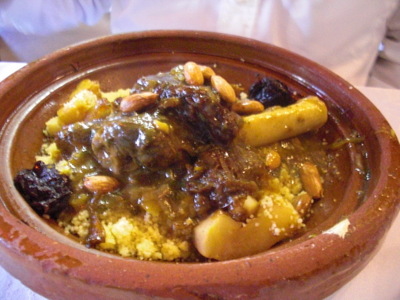
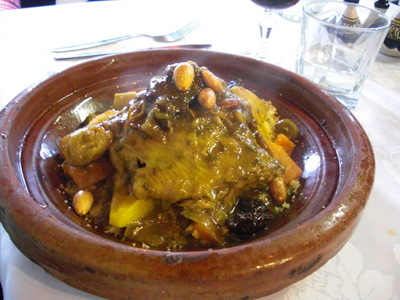 Back at Te Papa, I located David and colleague Buz Wilson (who got his doctorate in the Hessler lab, overlapped with David there, and is now at the Syndney Museum) and we all went out to dinner at one of the restaurants I had scoped out during my wanderings: a Moroccan place called, of course, Casablanca.
Back at Te Papa, I located David and colleague Buz Wilson (who got his doctorate in the Hessler lab, overlapped with David there, and is now at the Syndney Museum) and we all went out to dinner at one of the restaurants I had scoped out during my wanderings: a Moroccan place called, of course, Casablanca.
While we studied the menus, we were served a fourfold appetizer of hummus, an eggplant spread, tabbouleh, and mashed broad beans, all accompanied by pita wedges and all excellent.
Then we ordered three main courses and shared them all around: Left, a sweet lamb tagine with raisins and prunes. Right, a chicken tagine with vegetables and prunes. Below left, a savory lamb tagine with vegetables. On the side, the tasty assortment of olives shown below right. Again, all excellent.
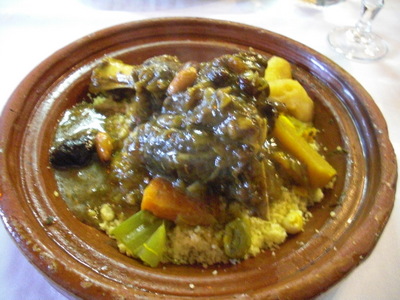
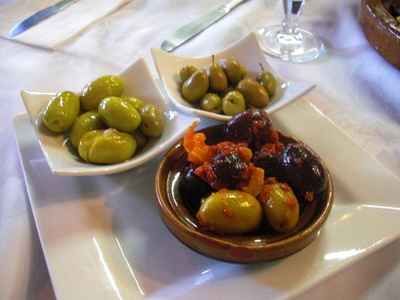 In most Moroccan restaurants we've visited, the tagines were served in the round, brown ceramic dishes of the same name, as they were at Casablanca (nominally the dishes in which they were cooked, covered the tall, conical lid typical of tagine dishes, although I suspect restaurants prepare them in larger batches and ladle them into the tagine dishes for serving), and a platter of plain couscous is served on the side, but here, they were served already spooned over mounds of couscous right in the dishes.
In most Moroccan restaurants we've visited, the tagines were served in the round, brown ceramic dishes of the same name, as they were at Casablanca (nominally the dishes in which they were cooked, covered the tall, conical lid typical of tagine dishes, although I suspect restaurants prepare them in larger batches and ladle them into the tagine dishes for serving), and a platter of plain couscous is served on the side, but here, they were served already spooned over mounds of couscous right in the dishes.
previous entry
List of Entries
next entry

 Wellington is built around the shores of its harbor, so naturally anywhere else you go is going to be uphill, and in this case, rather steeply uphill at that. The cablecar heads northwest from the center of town, whereas the number 10 bus, which goes to the zoo heads out almost due south. (By that sort of coincidence that happens to me all the time, I spent my time waiting for the bus on Courtenay Place chatting in French with a nice lady from Paris who was in town to visit her daughter, who works in the film industry.)
Wellington is built around the shores of its harbor, so naturally anywhere else you go is going to be uphill, and in this case, rather steeply uphill at that. The cablecar heads northwest from the center of town, whereas the number 10 bus, which goes to the zoo heads out almost due south. (By that sort of coincidence that happens to me all the time, I spent my time waiting for the bus on Courtenay Place chatting in French with a nice lady from Paris who was in town to visit her daughter, who works in the film industry.)
 It's a small zoo, in areal extent, and many signboards were at pains to explain why they don't have, for example, elephants— they can't provide space enough to keep such large animals happy and healthy without displacing a lot of other exhibits, so they've decided to concentrate on native species and species that are especially rare in zoos.
It's a small zoo, in areal extent, and many signboards were at pains to explain why they don't have, for example, elephants— they can't provide space enough to keep such large animals happy and healthy without displacing a lot of other exhibits, so they've decided to concentrate on native species and species that are especially rare in zoos.
 At one point, I rested my feet by showing up to watch the presentation on the "animal of the day," which turned out to be the dingo. After the short talk, the keepers brought the two leashed dingos out into the small audience to be petted. They were very wooly and soft, very friendly, and loved having their chins and ears scratched. The keepers emphasized that all zoo animals are trained, for their own health and safety as much as anything else, although not necessarily tame. For example, even dangerous animals like lions and tigers are trained, e.g., to present the left hip to a mesh-screened window on command, to facilitate administration of injections and drawing of blood samples.
At one point, I rested my feet by showing up to watch the presentation on the "animal of the day," which turned out to be the dingo. After the short talk, the keepers brought the two leashed dingos out into the small audience to be petted. They were very wooly and soft, very friendly, and loved having their chins and ears scratched. The keepers emphasized that all zoo animals are trained, for their own health and safety as much as anything else, although not necessarily tame. For example, even dangerous animals like lions and tigers are trained, e.g., to present the left hip to a mesh-screened window on command, to facilitate administration of injections and drawing of blood samples.
 At the left is the Malaysian sun bear, a new acquisition.
At the left is the Malaysian sun bear, a new acquisition.
 Back at Te Papa, I located David and colleague Buz Wilson (who got his doctorate in the Hessler lab, overlapped with David there, and is now at the Syndney Museum) and we all went out to dinner at one of the restaurants I had scoped out during my wanderings: a Moroccan place called, of course, Casablanca.
Back at Te Papa, I located David and colleague Buz Wilson (who got his doctorate in the Hessler lab, overlapped with David there, and is now at the Syndney Museum) and we all went out to dinner at one of the restaurants I had scoped out during my wanderings: a Moroccan place called, of course, Casablanca.
 In most Moroccan restaurants we've visited, the tagines were served in the round, brown ceramic dishes of the same name, as they were at Casablanca (nominally the dishes in which they were cooked, covered the tall, conical lid typical of tagine dishes, although I suspect restaurants prepare them in larger batches and ladle them into the tagine dishes for serving), and a platter of plain couscous is served on the side, but here, they were served already spooned over mounds of couscous right in the dishes.
In most Moroccan restaurants we've visited, the tagines were served in the round, brown ceramic dishes of the same name, as they were at Casablanca (nominally the dishes in which they were cooked, covered the tall, conical lid typical of tagine dishes, although I suspect restaurants prepare them in larger batches and ladle them into the tagine dishes for serving), and a platter of plain couscous is served on the side, but here, they were served already spooned over mounds of couscous right in the dishes.